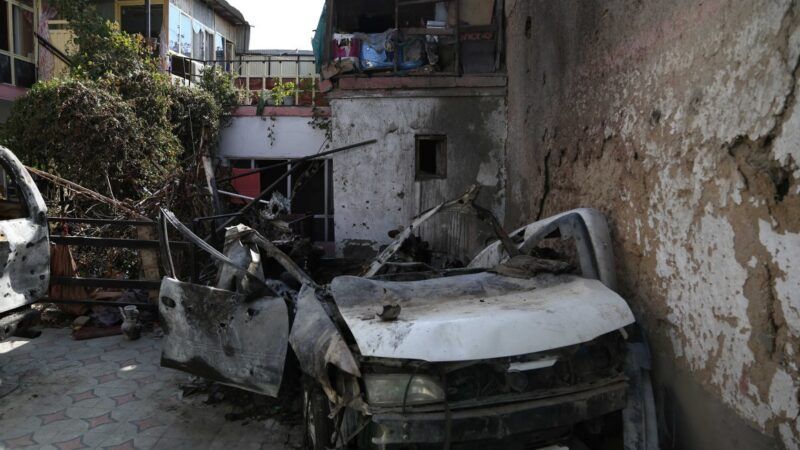Military Drone Strike That Killed Afghan Aid Worker, Children Has Hallmarks of Intelligence Failure
An independent investigation hasn't turned up terrorist ties or explosives.

The evidence increasingly indicates that a U.S. drone strike that took place outside Kabul as America withdrew from Afghanistan killed not a terrorist but an aid worker, along with nine other civilians, including several children.
On August 29, the U.S. military launched a strike on what Central Command said was a vehicle transporting explosives on behalf of the Islamic State. According to the Pentagon, the target posed an "imminent" threat to the Kabul Airport. This was just days after suicide bombers killed at least 170 Afghans and 13 U.S. troops, and tensions were high.
A military spokesperson said there were "significant secondary explosions" as a result of the drone hit. Gen. Mark A. Milley, chairman of the Joint Chiefs of Staff, called it a "righteous strike" that foiled a potential attack.
In reality, that strike hit a car that had been driven by humanitarian aid worker Zamari Ahmadi. Ahmadi was killed, along with two other adults and seven children. And follow-up media investigations are casting serious doubt on the military's account.
Credit both The New York Times and The Washington Post for reconstructing what actually happened. The Times has assembled an account of Ahmadi's final day, with the help of security surveillance footage, to show that what military intelligence may have assumed as suspicious behavior was Ahmadi's typical work. He worked for Nutrition and Education International, a California-based charity, and the sedan belonged to the organization. He is seen on camera loading the back of his white sedan with not explosives, but containers of water. The president of his group has denied that Ahmadi had any connections with the Islamic State.
Even more damning is what both the Post and the Times heard from experts analyzing the wreckage of the drone strike. Ahmadi's car was hit by a Hellfire missile with a 20-pound payload. The damage to the car and the courtyard where he was parked matched the amount of destruction associated with the missile, but the evidence that there were explosives in the car is sorely lacking. According to eyewitnesses, the "significant secondary explosions" did not take place.
The Washington Post commissioned an expert to write a 19-page analysis of the blast based on the evidence. In the Post's words, he concluded that "it was highly unlikely there was a substantial amount of explosives in the car and theorized fuel vapors may have played a role in a subsequent blast that appeared more destructive than it was." The explosion scorched the walls next to the car, but it would have destroyed it had other explosives been in the vehicle. Windows were blown out only in near proximity to the car.
The New York Times' put together a video detailing what its investigation uncovered: a discomfiting likelihood of a terrible intelligence failure. Ahmadi was allegedly under surveillance all day before the U.S. decided to launch the strike, but a source told the Times that the Americans had no knowledge that he had spent a chunk of the day filling bottles of water and loading them into the trunk of his car. They did not seem to know who he was, and they have yet to provide any evidence that Ahmadi has any terror ties. The drone strike seemed to have been carried out with about as much evidence that it would require for a police officer in the United States to get a search warrant.
The military was tracking communications it believed were from Islamic State terrorists. And the day after Ahmadi was killed, the Times reports, Islamic State terrorists did launch a rocket attack toward the airport from a neighborhood Ahmadi had traveled through the previous day. The vehicle they launched the attack from was a white Toyota, a sedan that looked a lot like Ahmadi's. Did they get the cars mixed up during surveillance? According to the Times, officials knew that Ahmadi's home was not the same address as the Islamic State safe house they were keeping tabs on.
We have no idea how frequently these types of seemingly mistaken strikes happen, partly because the military has been deliberately secretive and partly because what information we've gotten has not been trustworthy. Outside observers estimate that between 300 and 900 civilians killed by drone strikes in Afghanistan during the two decades Americans were there. There have been dozens, possibly even hundreds, of strikes like this.
And when whistleblower Daniel Hale leaked information showing how Washington was covering up evidence that these drone strikes were not as surgical as we were led to believe, the U.S. government prosecuted him. He was sentenced to 45 months in prison.